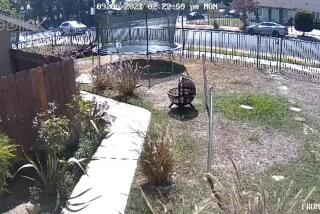Insurer intuition can land a car on the junk heap
- Share via
Deciding whether a vehicle should be declared a total loss after an accident is a mixture of science and art, and the amount of visible exterior damage may not be what determines the call.
Whether a vehicle gets hit by another, runs into a tree or gets pelted by hail, an insurance company may declare it a total loss before the cost of repairing damage reaches the vehicle’s market value.
“We use general guidelines and not hard and fast rules,” said Dave Smith, a claims manager for State Farm, the nation’s largest auto insurer. “The general guideline is that when you get to 75 to 80% of the value, you have to think about it as a total.
“It is very much an economic decision. The cost of repair parts and labor is definitely going to influence that,” Smith said, and the decision hinges on several variables.
As vehicles age and their value declines, they become more likely total candidates because the cost of labor is as high as on newer vehicles that are worth more, and parts may be just as expensive.
Progressive Auto Insurance says the likelihood of a 2002 or 2003 model being written off after an accident is 4.3%, and for a 1992 vehicle it is 18.8%. CCC Information Services, a Chicago company that provides data and technology for the insurance industry, estimates 3.5 million vehicles are totaled annually in the U.S.
Brand and vehicle design also play roles. Body parts cost more for a Mercedes-Benz than a Mercury and aluminum costs more than steel, but exterior damage may not be the reason a vehicle is written off.
A bent frame that can’t be straightened or interior damage from deploying air bags may tip the scales toward a total. “Air-bag replacement is going to be a key factor in deciding when a vehicle is going to be totaled,” said John Eager, senior director of claims services for the Des Plaines, Ill.-based National Assn. of Independent Insurers.
An association analysis in 2000 of accident damage reported the average repair cost for vehicles with air-bag deployments as $8,219 versus $2,177 for vehicles without.
Air bags and related hardware were only part of the additional cost. For example, the association said air-bag modules ranged from $356 for the driver side in a 1996 Subaru Legacy to $1,762 for the passenger side in a 1996 Lexus ES300.
On vehicles with dual front air bags, required on all models since 1999, the steering wheel and passenger side of the dashboard need replacement or repair after deployment. Air bags deploy with such force that they also can damage the windshield, sunroofs and stereo speakers.
Assessing the cost of replacement parts and labor is straightforward, but determining a vehicle’s market value is open to interpretation and often a point of contention between the insurer and the insured.
As is typical of the used-car business, insurance companies consider the engine, transmission, other major features, age, mileage and overall condition of the vehicle in setting a market value.
Ultimately, it is a judgment call. “It is a human view of the car,” Smith said, adding that it is based on data from the used-car market.
In some states, if an owner thinks they have been low-balled by the insurer, they could hire an appraiser and the insurance company could do the same. If the appraisers disagree, then a third appraiser’s opinion is sought. A decision by two of the three appraisers is binding for the insurer and the owner.
If a vehicle was totaled, the insurance company could pay the owner in cash or find a comparable replacement vehicle. That is the insurance company’s choice, but a cash settlement is usual.
When a vehicle is totaled, some money may go from the insured to the insurer. Totaled vehicles are claimed under collision or comprehensive coverage, and the usual deductibles apply.
Without collision and comprehensive coverage, an owner would not be covered by their insurer. If another party were at fault, the consumer would have to collect from the other person’s insurance company.
When a claims adjuster pores over a vehicle that may be totaled, he isn’t assessing damage only from the most recent accident. He also looks for damage from previous events, such as a dent caused by another vehicle or backing into a lamppost.
As for what happens to a vehicle after it is damaged in an accident, sometimes it could resurface on the used-car market.
Indeed, in a 2002 investigation, Consumer Reports magazine identified 41,800 vehicles that had been totaled by insurers and found that 20% had been retitled for use on public roads. Of the 8,300 put back on the road, the magazine said the titles for 2,500 were washed of any history they had been totaled and declared salvage vehicles.
“Everybody assumes that when a vehicle is totaled, it goes to the shredder,” said Jeff Blyskal, a senior editor who worked on the investigation and wrote the articles that appeared in the January 2002 issue. “That’s definitely not the case.”
Blyskal suggests services such as Carfax (www.carfax .com) and Experian Automotive (www.autocheck.com), which track title histories by vehicle identification numbers. “If it ever did have a salvage title, it would show up in the history of the vehicle even if it isn’t on the latest title,” Blyskal said.
Both services charge $14.99 to check a single vehicle or $19.99 for multiple vehicles and say their reports will show whether a vehicle was issued a salvage title, damaged by flood or rebuilt.
Blyskal also advises to look for signs such as poorly aligned body parts, paint overspray and air fresheners to hide odor from water damage. When starting the engine, if the air bag indicator doesn’t light up, either the air bags aren’t functioning or weren’t replaced after an accident. Another hint: Have a friend follow a test drive in another vehicle to see whether the car tracks straight or at an angle, what Blyskal calls a “diamond shape” and others refer to as a dog trot.






